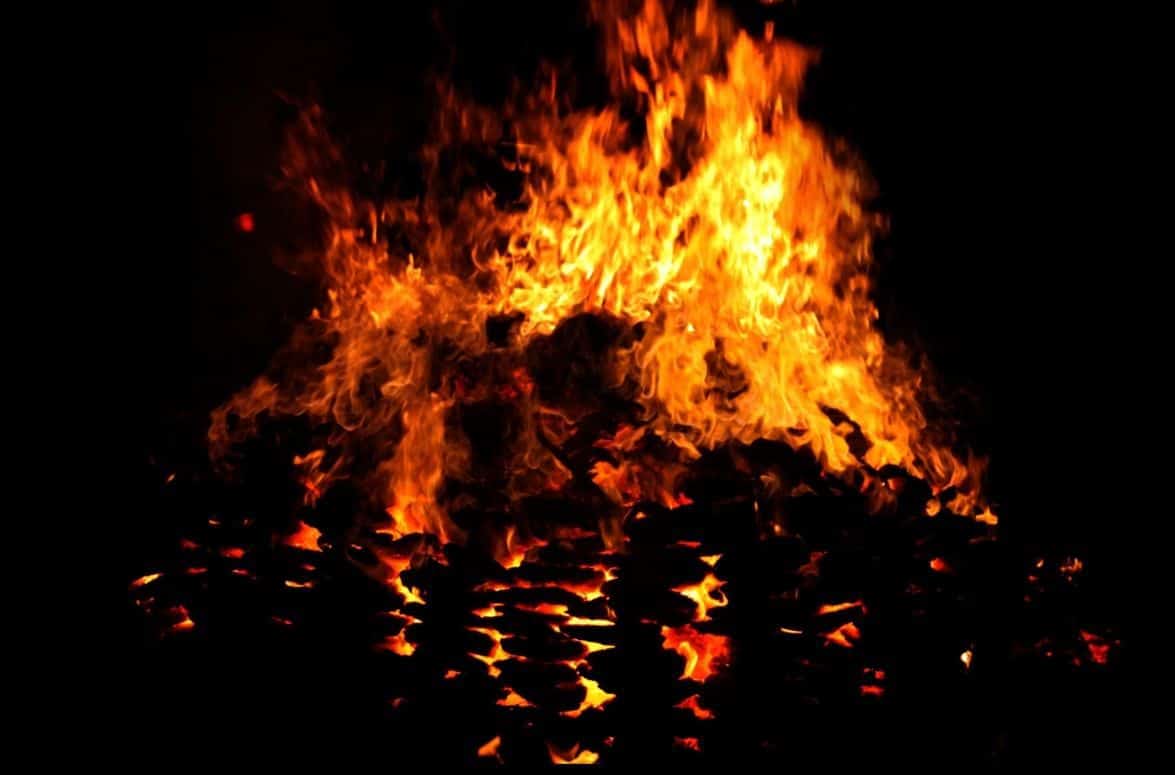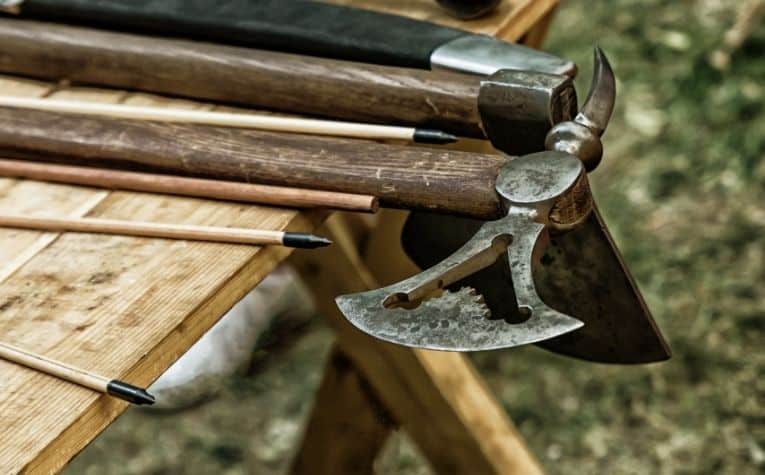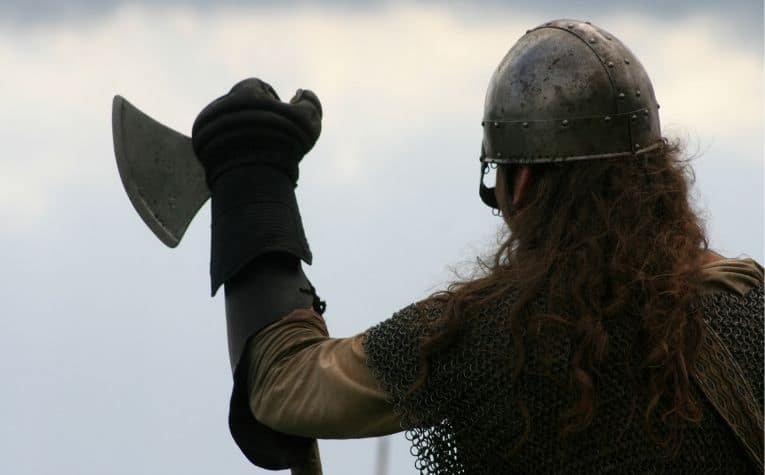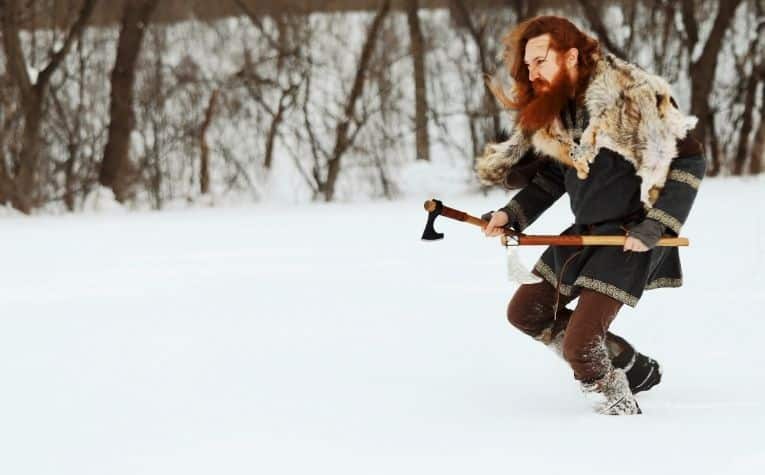In Norse Mythology, What's the Name of the Great Hall Where Fallen Warriors Go After Death?
During the height of the Viking Era, seafaring warriors from what is now Scandinavia terrorized Northern Europe as they raided and plundered towns and villages that could not defend against them. It is widely believed that the courage and ferocity of the Viking invaders were rooted in their deeply-held belief that to die in battle was honorable and great rewards awaited them in the afterlife.
Valhalla is closer to the concept of heaven than it is to hell, but it is not an exact parallel. Located in Asgard, Valhalla is where Odin, the god of thunder, reigns. Valkyries, Odin's maiden warriors, select which elite Viking warriors may enter. The description of Valhalla is what the Vikings would have considered a paradise.
Many popular beliefs regarding Norse mythology and the Viking way of life (and death) are not entirely accurate. Some common notions of the Viking afterlife are inaccurate and do not tell the whole story, while other misconceptions are the result of facts becoming obscured over time. What is certain is that the real facts will likely surprise you while deepening your understanding of the Viking world.
How accurate are modern depictions of Vikings? See What Did the Vikings Really Look Like? to learn more.

Valhalla is Heaven, but Not for All Vikings
Valhalla is widely perceived (somewhat correctly) as the final resting place for Viking warriors killed on the battlefield. As described by Old Norse sagas and texts, Valhalla is a realm of the Norse afterlife that Vikings aspired in life to enter upon their death.
So in this sense, Valhalla is similar to the Christian concept of heaven. However, there are major distinctions between the two, starting with who was permitted to enter and how.
As described in Old Norse writings, Valhalla ("hall of the slain") is a great hall located in Asgard, one of the nine realms in the Norse universe. It is where fallen Viking warriors and leaders walk among Norse gods, including the greatest of them all, Odin.
With golden, shimmering towers, a roof thatched from shields, and rafters made from spears, Valhalla is a marvelous sight, particularly through the eyes of a Viking warrior.
Odin is accompanied in Valhalla by his beautiful maiden warriors, the Valkyries, who are tasked with selecting the bravest of fallen Viking warriors to join their ranks.
What is sometimes overlooked is the fact that not only do the Valkyries select who among those killed in battle will emerge in Valhalla, but they also choose who lives or dies as the battle unfolds. [1]
Interested in Norse Mythology? See 14 Great Books on Norse Mythology that explain the gods, heroes, and villains of these ancient stories of Scandinavia.

There Are Two Heavens in the Viking Afterlife
Interestingly, the bravest and fiercest of Viking warriors and Norse leaders may not end up in Valhalla upon their death. In fact, at most, only half of them do.
There is another realm of the Viking afterlife that also seeks the most courageous and heroic of souls, and by some accounts, it even has the first choice of fallen Vikings from the field of battle.
Known as Folkvangr ("field of the army"), this afterlife is ruled by the goddess Freya, whose dominion includes matters of love, beauty, and fertility.
While Valhalla is the presumptive Viking heaven in the minds of many, in reality, only half of Norse's fallen soldiers and warriors end up there.
The other half, equally noble and honorable in death, pass on to Folkvangr, the lesser-known but equally prestigious realm of the Norse afterlife. [2]
Whether fallen Viking heroes earned the distinction of reaching the hallowed halls of Valhalla or the idyllic fields of Folkvangr, there was a catch to residing in warrior paradise.
Even in Valhalla, All Good Things Must Come to an End
Viking sagas describe Valhalla as a warrior's paradise. Days are spent honing battle skills, and any injuries suffered in the heat of fighting are miraculously healed by day's end.
Nights are spent feasting in the company of the great god Odin, fellow warriors, and the revered Valkyries. These scenes are re-lived each morning, but not for eternity. (Also see Do People Still Believe in Odin?)
Even in Valhalla, the hard-nosed and practical warrior mindset rules all. It explains why only elite warriors (known as the Einherjar) were selected to join Odin in Asgard.
According to Norse mythology, age-old prophecies foretold a battle royale that would be the war to end all wars, with virtually all forms of life completely wiped out, giving rise to a rebirth of the cosmos.
According to Viking lore, there would come a time when Odin and his legions of Einherjar would face off against the great wolf Fenrir in an epic battle pitting the good and noble against the forces of all-powerful evil.
This cosmic conflict is known as Ragnarok, and sadly, the outcome has been predetermined, with Odin and his entire army fated to meet their end in defeat.
Despite the tragic and horrific fate that awaited them in the afterlife, Vikings were all too willing to lay their lives on the line on the fields of battle for their family legacy in the mortal realm and the camaraderie and honor that awaited them in Valhalla. [3]
Like Valhalla, goddesses are important to the Norse belief system. See 10 Goddesses in Norse Mythology That You Need to Know to learn more.

Five Destinations in the Viking Afterlife
The concept of the afterlife figures prominently in Norse culture, religion, and society. The Vikings believed in no less than five separate realms of the afterlife.
Valhalla is the best known, with Folkvangr also receiving its fair share (albeit significantly less than Valhalla) of prominence in Viking lore.
Valhalla and Folkvangr are the two afterlife destinations for brave warriors killed in battle, but what happened to the hardworking Norse farmer or good-hearted peasant when they died?
According to Norse mythology, they too had a realm in the afterlife where their soul would reside after departing Midgard, the inhabited realm of the Viking universe.
These are the five realms of the Viking afterlife, each catering to a particular segment of Norse society:
- Valhalla – The "hall of the slain" houses the god Odin, his warrior-maidens, and fallen Viking heroes, as they train and feast until Ragnarok, the Norse version of the apocalypse.
- Folkvangr – Those not selected by Odin's Valkyries to enter Valhalla (or vice-versa according to certain accounts) find themselves in the company of Freya in Folkvangr. Equally idyllic, but with the same doomsday fate as Valhalla, the warriors in Folkvangr know that Ragnarok awaits them.
- Hel (also known as Helheim) – Despite sounding eerily similar to the undesirable Christian afterlife hell, Hel is the destination for the overwhelming majority of Viking citizens who led normal lives farming, raising livestock, or performing a trade.
Hel is overseen by a goddess of the same name. Although most Vikings would likely spend their afterlife there, not much has been written about it, other than it is reserved for those who die in a manner not worthy of selection to Valhalla or Folkvangr. (Also see Did Vikings Have Tattoos?)
Within Hel, there is a place reserved for the evil of heart, which bears a resemblance to the Christian notion of hell.
Known as Nastrond, murderers, cheaters, and the like could expect to spend the afterlife there with all the darkness and horror one would expect to be reserved for the wicked.
- The Realm of Ran – Known as much for their seafaring expertise as for their raids throughout Northern Europe, it should come as no surprise that Norse mythology has a realm in the afterlife reserved just for sailors and those lost at sea.
The goddess Ran (who is also a giantess) lives at the bottom of the ocean, where she rules over amassed treasures and the souls of those who made their livelihood (or met their demise) on the high seas.
- Burial Mounds – Not all the souls of dead Vikings head on to another realm. Some stay with their bodies and linger around the burial mound where their corpse is buried. Akin to ghosts, these spirits could be benevolent, or in some cases, malevolent.
A Huagbui ("mound-dweller") is eternally connected to their burial site and co-exists peacefully with the living unless their gravesite is disturbed or their buried possessions are wrongfully taken, in which case they may become a dangerous entity to deal with.
In contrast, a Draugr (also known as an Aptrgangr – "one who walks after death") is to be feared by the living. Old Norse tales describe Draugrs killing innocent people, slaughtering livestock, and destroying property and belongings. [4]
There may be a sixth realm in the Norse afterlife known as Helgafjell. On this holy mountain, the recently dead are reunited with family and loved ones who had previously passed to spend eternity "living" a peaceful existence.
Of all the Viking afterlife's realms, this is perhaps the most innocuous and benign (but also the most generic). [5]
There are many interesting creatures in Norse mythology. See The Giants of Norse Mythology: Who Are They? to learn more.

Viking Connectivity to the Modern World
One Viking figure who certainly would have found himself in Valhalla's majestic halls, feasting on wild boar and imbibing mead with other Norse leaders, was King Harald Gormsson, who ruled from 958 to 987 A.D.
It is believed that King Harald was mortally wounded in battle while fending off forces loyal to his son Svein who was leading a rebellion against his father. [6]
King Harald is credited with bringing Denmark and Norway under one common rule, thereby unifying the Viking kingdom.
This feat alone places him in elite company in Norse history and would certainly have made him an excellent selection for Odin's Valkyries.
However, his nickname has forged an everlasting link between his rule over a thousand years ago and today's modern world.
King Harald was often referred to as Harald Bluetooth , owing to his dead and discolored tooth.
In 1996, tech companies Ericsson, Nokia, and Intel collaborated on a short-range connectivity technology that was internally code-named Bluetooth (as an homage to how King Harald "connected" and unified the Viking kingdom) until a formal name was decided upon.
Today, the name Bluetooth is synonymous with a vital form of technology that enables people to connect their devices to various equipment wirelessly.
In a larger sense, it creates an unparalleled level of connectivity that is enjoyed around the world.
Even the iconic Bluetooth logo is a hybrid of Harald Bluetooth's initials in the old Viking rune alphabet, Hagall (ᚼ), and Bjarkan (ᛒ). [7]
Interested in Norse Mythology? See 14 Great Books on Norse Mythology that explain the gods, heroes, and villains of these ancient stories of Scandinavia.
The Lord of the Rings Trilogy and Norse Mythology
The beloved author of The Hobbit and The Lord of the Rings trilogy, J.R.R. Tolkien, was unabashedly fascinated by Norse mythology. From it, he found great inspiration for his famous literary works.
Two sources, in particular, are known to have influenced the writing of these literary classics.
One was Tolkien's live-in nanny who hailed from Iceland and shared Icelandic stories and mythology with the English author.
The other was the body of Old Norse writings that planted the seeds for what would become the universe that Tolkien created to stage his stories. [8]
The Icelandic sagas that Tolkien began reading from a young age inspired many of the key elements of his stories, including:
- Dwarves, elves, and other mythical beings and creatures
- The significance of rings and swords
- Wise wizards and demi-gods (comparisons have been made between the Norse god Odin and Tolkien's character Gandalf)
- Middle Earth, which figures prominently in Tolkien's stories, is the English translation of Midgard
- Valinor in Tolkien's world bears a strong resemblance to Asgard in Norse mythology
Women played an important role in Viking culture. See Did Female Vikings Go to Valhalla? to learn more.
Iceland and Norse Mythology
The most significant writings (as far as Viking lore) come not from Denmark, Norway, Sweden, or even the European continent, but rather, a place nearly a thousand miles away from Scandinavia – the island of Iceland.
Norse stories relating to the Viking way of life and its mythology were traditionally passed down orally.
In the 13th century, the Icelandic poet Snorri Sturluson wrote a body of work to preserve the skaldic (native Norwegian and Icelandic style) poetry. In so doing, he created a written record of Norse mythology.
Although Sturluson was a Christian writing about pagan gods and what was considered by Christians to be a heathen society, his works such as the Poetic Edda and the Prose Edda rely upon today for insight into Norse mythology and the Viking way of life. [9]
The Norse worldview is full of fascinating characters. See 25 Norse Gods You Need to Know to learn more.
The End of the Viking Era
Ironically, it was not conquest, plague, or infighting that led to the end of the Viking era. It was the conversion from their "heathen" ways and worship of pagan gods like Odin and Thor to Christian values and beliefs. Raiding and plundering was no longer as profitable nor as appealing
In other words, once they converted to Christianity, the Vikings slowly but surely ceased being Norse warriors.
They became Germans, Scots, English, and so on, as they assimilated into their surroundings (and in most cases, previously conquered lands). [10]
Life in Midgard: Other Interesting Viking Facts
The Vikings believed the universe consisted of nine separate realms, each inhabited by different beings.
Of particular consequence to the typical Viking was Midgard ("middle earth"), the realm of humans, and Asgard, the realm of the gods and home to Valhalla and Folkvangr. [11]
While Norse mythology helped explain questions about their origin and the afterlife while providing a moral compass of sorts, Vikings were largely left to their own devices as they fought and lived in Medieval Europe.
Much is made of their brutality in battle and seafaring exploits, but turning the lens on their domestic lives is equally revealing.
Norse mythology and Christianity were heavy religious influences on the Vikings. Compare them here: Norse Mythology vs Christianity to learn more.
How Did Vikings Get Married?
Life during the Viking era (not just in Scandinavia but just about anywhere in the world) was difficult and significantly shorter by today's standards.
Like many cultures of that time, the Vikings were a male-dominated society, but this is not to say that women were not vital and contributing members of the Viking community.
While the men were away fighting battles or raiding distant lands, the Viking women had to pull double-duty, performing both their tasks and those of their absentee husbands.
Marriages were arranged by the bride and groom's families and completed before the parties reached 20 years of age (Viking wives could be as young as 12).
Considering that the average life expectancy was well below 50, this accelerated timetable is understandable. (Also see Were the Vikings Tall?)
Both sides' families were invested in the union, both literally and figuratively. The groom's side essentially purchased the exclusive right to marry into the bride's family (a formal contract, if you will).
The bride's family reciprocated upon marriage by way of a dowry paid to the groom's family. Given the financial ramifications for those involved, marriage was not a matter taken lightly by the Vikings.
Viking wives enjoyed more freedoms and rights than their European counterparts during that era.
For instance, they had the right to divorce their husbands, own property, accumulate wealth, and even trade their goods and wares.
It is even believed that Viking women fought alongside male warriors on the fields of battle, which goes to show that bravery was not a trait found only in Viking men. [12]
People certainly believed in Valhalla in the Middle Ages, but what about today? See Do People Still Believe in Valhalla? to learn more.
How Many Wives Did Vikings Have?
Although Viking women enjoyed greater independence than their counterparts throughout Europe, they still existed in a male-dominated culture.
Polygyny (marrying multiple wives simultaneously) and maintaining concubines were common among rich and powerful Viking men.
Recent studies theorize that these practices were so widespread that competition for wives was very fierce.
Much of the motivation underlying Viking raids and the plundering of neighboring lands was not greed or bloodthirst, but rather, the desire by Viking warriors to accumulate wealth and social status to make themselves appealing suitors for the dwindling numbers of marriage-eligible Viking women. [13]
Final Thoughts
While not all Viking citizens wielded a sword during their lifetimes, those who stepped onto a field of battle did so knowing they could very well die there.
To die in battle was the most honorable and noble of deaths to the Norse people, even though it would be but the first of two violent ends that they would meet.
In this sense, the Vikings lived and fought in Midgard as they did in Valhalla.
References:
[1] Source
[2] ancient-origins.net
[3] norse-mythology.org
[4] ancient.eu
[5] Source
[6] Source
[7] Source
[8] Source
[9] Source
[10] What Happened
[11] https://norse-mythology.net/
[12] History on the Net
[13] The Vintage News
In Norse Mythology, What's the Name of the Great Hall Where Fallen Warriors Go After Death?
Source: https://scandinaviafacts.com/is-valhalla-heaven-or-hell-10-facts-that-might-surprise-you/
0 Response to "In Norse Mythology, What's the Name of the Great Hall Where Fallen Warriors Go After Death?"
Post a Comment